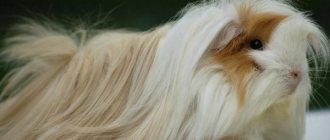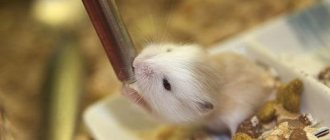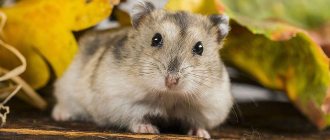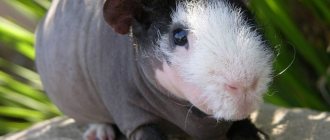Description of the rodent
Before you decide to have a hairless rat as a pet, it is recommended that you become a little more familiar with the characteristic features of the breed.
Appearance
The main distinguishing feature of sphinx rats is the lack of fur. At the same time, in some areas - the muzzle, in the area of the hind legs, in the groin area, a small amount of hair is allowed. In addition, hairless rats have the following characteristics:
- standard size – 23-25 cm;
- body weight 350-750 g;
- downward curled mustache;
- lack of eyelashes;
- light pink skin, less often – smoky, brown, beige;
- large ears.
Sphynx rats have eyes of almost any color: red, black, pink. But in rare cases, baby rats are born with different eyes. The price for such individuals almost doubles.
Sometimes in a pet store, sellers try to pass off the so-called pseudo-Sphinx as a real one. “Fake” differs in that the animal’s fur grows in clumps. This is due to constant molting. While the fur grows in one area, the fur falls out in the next area. Therefore, when choosing, it is worth remembering that a purebred rat should be completely bald.
Character and behavior
Sphynxes are rightfully considered one of the smartest rat breeds. Most individuals are even subject to training. With daily exercise, the pet is able to carry out such simple commands as “come to me”, “give me your paw”, “lie down”.
Due to their specific appearance, sphinx rats often give the impression of aggressive, vindictive animals. However, in this case, the situation is exactly the opposite - hairless rodents are very good-natured, calm, love to spend time with their owner and are very attached to humans.
Choosing a name for Dumbo the rat?
The owners are trying to give the young, smart baby Dumbo a deep and meaningful nickname in the hope that the animal's name can influence the character and intelligence of the funny animal. Sometimes it can be difficult to immediately name a pet with a suitable name that emphasizes its individuality and expresses the love of its owner.
It is advisable to take a few days to take a closer look at the habits and character traits of the new family member; most likely, he himself will tell the owner what to call him. The furry baby's nickname can be tied to the color of the rodent's coat and funny ears, human associations from the pet's appearance and funny faces, favorite book and cartoon characters or pop stars. The rodent's nickname should be simple and easy to pronounce in a diminutive form. It is believed that females respond better to nicknames that begin with the letters K, M and D. Males are more fond of names with the letters S, K, M and D, long-eared pets are more willing to get used to nicknames with the letters T, N, L, M, K , S, Sh and R.
The name for a Dumbo rat girl can be: Knopa, Scully, Masya, Dana, Molly, Ksyusha, Marta, Alice, Dasha, Klava, Matilda, Gina, Darcy, Alpha, Kayla, Linda.
The name for a dumbo boy rat can be: Kuzya, Tyson, Tim, Rocky, Simson, Garik, Steve, Venya, Bucks, Rocky, Dick.
It doesn’t matter what the owner calls the smart-eared baby. In any case, the baby rat Dumbo will sincerely adore and faithfully wait for his beloved owner, giving him his incredible tenderness and selfless love.
Video
Types of sphinxes
Among hairless rats, professional breeders distinguish 3 main varieties:
- Standard . The body length and weight of representatives of this variety completely coincide with those of the standard breed. Standard Sphynx cats have a slight amount of hair on their face and hind legs. The skin is pale pink, the whiskers are long. A distinctive feature is the presence of circles under the eyes. For this feature, breeders nicknamed the animals porcupines.
- Rex . They are distinguished by short curly fur and short curled whiskers. The head, limbs and groin area have a thicker coat. With the onset of molting, the fur falls out completely for a certain period. Individuals of smoky and silver shades are especially valued. More information about the breed can be found here.
- Double Rex . Sphynxes of this variety are distinguished by a completely hairless body. On the folded skin of a light pink shade there is not a single hair present at all. This makes the image of the animal very mysterious.
Lack of fur is inherited by rat pups. But the gene responsible for the presence of fur is recessive, that is, it is easily suppressed. Therefore, among sphinxes there are several subspecies: completely naked, nude, cropped, fluffy, with receding hairline.
In newborn rats, the coat periodically changes - it grows and then falls out. Therefore, it is possible to finally classify a pet as one or another subspecies only at the age of 5-6 weeks.
Pros and cons of the breed
Like any breed of decorative rats, the Sphynx has its advantages and disadvantages:
Pros and cons of the Sphynx breed
absolute hypoallergenic;
cleanliness, absence of foreign odors;
extraordinary mental abilities;
good disposition, willingly make contact with the owner, show affection and affection;
original external data.
the need for keeping in groups;
freezes in the cold season;
relatively short life expectancy.
Also, one of the main advantages of the breed is complete understanding with the owner. Experienced breeders claim that hairless rats can sense a person’s mood on an intuitive level.
Character
Hairless rats are very active, curious and peaceful creatures; they quickly become tamed and become attached to their beloved owner. The lack of fur obliges the owner of a bald pet to hold his little friend in his arms as often as possible, stroke, kiss the fluffy rodent, carry it in his bosom and on his shoulder. The warmth of the human body warms and calms naked animals; in response, the animal does not skimp on showing tender affection and sincere feelings.
Sphinxes very sensitively sense negative intonations in the owner’s voice; fright from a sharp cry can cause a stroke in these gentle animals. A person should communicate with kids in a gentle and friendly voice; rats immediately greet the owner, enjoy close communication and fun outdoor games.
Sphynxes are particularly clean; while walking, adults do not dirty the territory, but try to do all their toilet chores in their cage.
Lifespan
The average lifespan of sphinxes is 2-2.5 years. This is slightly less than the age of rats of other breeds. Premature death is explained by the predisposition of hairless rodents to a variety of diseases, for example:
- renal and liver failure;
- neoplasms;
- diabetes;
- pathologies of the heart and blood vessels;
- stroke;
- allergic reactions;
- cystitis.
In addition, due to the lack of fur, Sphynx cats are prone to developing colds. Additional problems are caused by exposure to direct sunlight. Under the sun, the rat becomes very overheated, even to the point of heatstroke. And on delicate skin, symptoms of dermatitis appear or burns form.
It is worth noting that despite all the health problems, if the animal is provided with proper care and periodic preventive examinations by a veterinarian, the life expectancy of a hairless rat can be more than 3 years.
Care and maintenance
Since the skin of rats is very sensitive to environmental conditions, before purchasing a pet you will need to take care in advance of organizing an appropriate microclimate in the room with the cage. Particular attention should be paid to the temperature regime - in order for the animal not to freeze, the air temperature in the room should be +23-27ᵒC. It is also necessary to curtain the windows so that the sun's rays do not fall on the animal. Humidity should be 55-65%.
The following requirements apply directly to the animal cage:
- Sphynx rats are active animals, so it is better to buy multi-tiered cages for them; you also need to install several equipment inside for exercise: ladders, ropes, a running wheel, tunnels;
- rats need their own cozy corner where they can retire or just relax - for these purposes, a special house should be equipped inside the home;
- The cage must have a removable tray; it is recommended to fill it only with natural materials, for example, sawdust or shredded toilet paper.
In order for your pet to always feel good, it is necessary to provide him with a number of hygiene measures:
- Wipe the animal’s body daily with a damp soft cloth, paying special attention to the face and groin area;
- If peeling and irritation occurs, treat the skin with a moisturizer, for example, Baby Cream or Bepanten;
- As they grow, carefully trim the rat’s claws with nail scissors;
- bathe the rat once a month - you can use a regular basin for bathing, but the water should not be hot.
The rodent also needs to grind down its constantly growing front teeth. For these purposes, you will need to place a mineral stone or a small wood twig in the cage.
Sphinxes are clean animals. Therefore, for the comfort of the animal, it is necessary to ensure regular cleaning of the cage. 1-2 times a week you need to change the filler and wash the tray with boiled water. Once a month - carry out general cleaning. To do this, you need to evict the pet for a while. After that, wash the cage itself and everything that is in it with baking soda.
Basic moments
- Despite their external pretentiousness and somewhat distant look, the Don Sphynxes are considered perhaps the most good-natured and peace-loving creatures on the planet.
- The body of representatives of this breed is always warm, if not hot, so if you urgently need a live heating pad, the Don Sphynx is happy to offer its services.
- Don Sphynxes eat much more than average cats. The increased appetite is explained by the intense metabolism inherent in all hairless purrs.
- The breed is not hypoallergenic in the full sense of the word. Nevertheless, the absence of fur makes it possible for its representatives to coexist peacefully with people with allergic reactions to the Fel D1 protein.
- Most Don Sphynx dogs show an almost dog-like attachment to one owner and have a hard time with the need to move to another family.
- In terms of care and maintenance, the breed needs increased attention, including concern for the temperature conditions of the room in which the animal lives.
- Don Sphynxes are typical kinesthetics who cannot live without touching a person once again. This is why they are often called “kissing” cats.
- These hairless eared cats love warmth and love sunbathing. But since excess ultraviolet radiation does not have the best effect on the skin of exotic pets, their exposure to sunlight must be carefully dosed.
The Don Sphynx is a bright, extraordinary appearance combined with a gentle character that is atypical for the cat family and a strong dependence on the owner. Most representatives of the breed are real “cotops”, able to simultaneously act both as a cozy sofa pet and as an inquisitive companion who willingly shares leisure time with the owner. In addition, these sophisticated creatures make excellent physiotherapists, skillfully dealing with the consequences of neuroses and other unpleasant ailments.
What to feed a rat
The pet's health largely depends on the Sphynx's diet. In order for the rat to develop normally and always feel good, you will need to organize a balanced diet for it, taking into account the following recommendations:
- The menu should be based on specialized grain feed. In this case, it is better to choose premium or super-premium products.
- The diet must be varied with natural products: succulent food (fresh herbs, fruits, vegetables), protein products (cottage cheese, kefir, fermented baked milk, lean meat, eggs, fish), nuts, seeds.
- To strengthen internal organs and the immune system, you need to add a few special vitamin and mineral complexes to the feeders.
- From time to time, the rat is allowed to pamper with treats for rodents - grain cookies, tasty fruit sticks, dried carrots, pine cones.
- To ensure normal metabolism, you need to provide the rat with plenty of fluids. To do this, it is enough to install at least 2 drinkers in the cage.
It is also necessary to exclude some harmful foods from the Sphynx's diet: candies, chocolate, carbonated drinks, baked goods, potatoes, fatty and fried meats, sour, hot, spicy dishes, fresh milk.
It is recommended to place 2 feeders at once in a rat cage. One is for industrial feed, the other is for natural food.
You need to feed your Sphynx often, but little by little. Small meals will ensure good metabolism. It will also help improve intestinal motility.
Feeding
To live a full life, rats need a balanced diet. It should include:
- Cereals as the basis of nutrition. Rats can be given specialized kits from a pet store, fed with bread and boiled corn.
- Fruits and vegetables should please the beast every day - cabbage, carrots, apples should definitely be included in the diet.
- The role of vitamin replenishment is played by treats in the form of lollipops, sticks, and sweets from the pet market.
- Protein foods are served less frequently, about twice a day. These are cottage cheese, meat products, yoghurts. The main thing is not to give protein more often, otherwise the rat will age faster.
Rats are recommended two meals a day - morning and evening. It is best to serve food at the same time. This will avoid possible problems with the digestive system. However, if we are talking about a pregnant female, then feeding is increased up to 3-4 times a day. The same applies to growing rat pups.
Breeding
Sphynxes reach sexual maturity quite early, at the age of 5-6 weeks. However, pregnancy and childbirth at this age have a very negative impact on the health of females. Therefore, mating must be postponed until the pet reaches 2-3 months. The interesting situation of the rat is indicated by the absence of weekly heat, changes in behavior, and also a noticeable weight gain (especially in the abdominal area).
Rats have a well-developed maternal instinct. Therefore, until the age of 3-4 weeks, the mother takes care of the offspring completely herself. It is not recommended to pick up babies, otherwise the rat may refuse them or even eat them. The culprit is a foreign odor emanating from human hands.
If the mother rat refused to feed her offspring, you need to help the babies. To do this, you can ask for help from friends whose rat also recently gave birth. Rodents have good lactation, so the female will be able to feed both her cubs and decoys. You can also try to feed the baby rats yourself using a syringe.
2-3 hours after birth, the female is again ready for mating. Therefore, all cage neighbors need to be removed from the new mother and her little rats. Also, when the babies reach 5 weeks of age, the boys will need to be separated, since sexually mature young animals will begin to actively mate with their mother and sisters.
Experienced breeders recommend maintaining an interval of 2-2.5 months between adjacent pregnancies. If the female has health problems, it is better to sterilize her.
How much does a hairless rat cost?
The cost of a Sphynx rat can vary greatly depending on several factors. For example:
- Place of purchase . In a pet store you can buy a bald pet for only 500-700 rubles. While professional breeders sell baby rats for 1000-1500 rubles apiece.
- Age . An adult rat, with a fully formed character and habits, costs much less than a baby rat, which can be raised from scratch.
- Features of appearance . Prices for unusual rats, for example, with eyes of different colors, can reach 2-2.5 thousand rubles. Also considered more valuable are individuals that have no fur at all.
The hairless Sphynx rat is not only an exotic pet. A hairless pet can become a true friend for its owner. The main thing is to provide the animal with attention, love and care. And the sphinx will definitely reciprocate.
What to pay attention to
The bald rat will become your faithful friend, the main thing to keep in mind is that:
- When buying a rodent, you take responsibility for its health and life.
- Try talking to a rat and stroking its belly. She'll really like it.
- Considering that your new friend has no fur, he needs to be kept at a comfortable temperature.
- If rats of this breed develop fur and begin to grow hair, you will need to pay attention to their health and diet.
A bald rat has overgrown hair - an indication that it is cold. For this pet, indicators such as temperature, daily routine, and careful hygienic care are of great importance. She needs the attention and care of her owner. Hairless rats feel comfortable at temperatures not lower than 20 degrees above zero. If these conditions are met, then the appearance of hair is excluded, it will not grow back.











